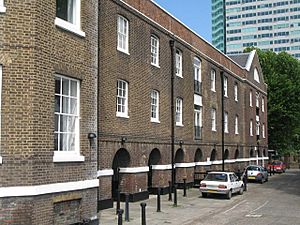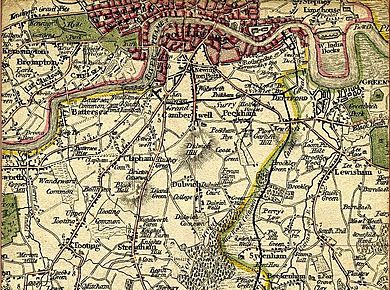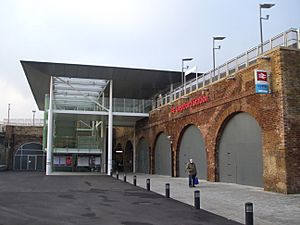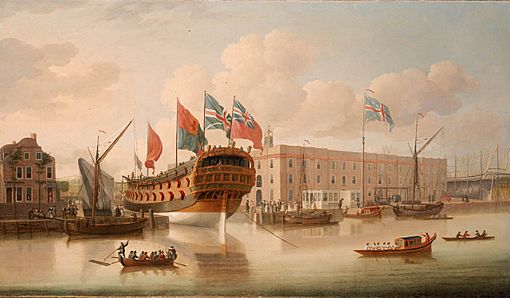Deptford facts for kids
Quick facts for kids Deptford |
|
|---|---|
 An anchor at the southern end of Deptford High Street links Deptford to its dockyard history |
|
| OS grid reference | TQ365775 |
| • Charing Cross | 4.7 mi (7.6 km) WNW |
| London borough | |
| Ceremonial county | Greater London |
| Region | |
| Country | England |
| Sovereign state | United Kingdom |
| Post town | LONDON |
| Postcode district | SE8 |
| Dialling code | 020 |
| Police | Metropolitan |
| Fire | London |
| Ambulance | London |
| EU Parliament | London |
| UK Parliament |
|
| London Assembly |
|
Deptford is an area in southeast London, located on the south bank of the River Thames. It is part of both the Royal Borough of Greenwich and the London Borough of Lewisham. The name Deptford comes from a "deep ford" across the River Ravensbourne.
For many years, from the mid-1500s to the late 1800s, Deptford was home to Deptford Dockyard. This was the very first of the Royal Dockyards. It was a major place for building ships. Famous people like Peter the Great, the Russian ruler, even came here to learn about shipbuilding. Deptford and its docks are also linked to Sir Francis Drake being knighted by Queen Elizabeth I on his ship, the Golden Hind. It's also connected to Captain James Cook's third voyage on HMS Resolution.
Deptford started as two small communities. One was by the ford, and the other was a fishing village on the Thames. But Deptford's history and growth are mostly tied to the docks. These docks were started by Henry VIII. The two communities grew together and became important when the docks were the main center for the Royal Navy. Some grand homes were built then, like Sayes Court, where diarist John Evelyn lived. The area became less important when the Royal Navy left. Then, the commercial docks also closed, with the last one, Convoys Wharf, shutting down in 2000.
Deptford was its own borough, called the Metropolitan Borough of Deptford, from 1900 to 1965. After that, it became part of the new London Borough of Lewisham.
Contents
History of Deptford
Deptford got its name from a deep crossing point over the River Ravensbourne. This was near where the Deptford Bridge DLR station is today. This crossing was part of an old Celtic path. The Romans later paved this path, and it became the medieval Watling Street. The name "Deptford" means "deep ford."
Deptford was on the pilgrimage route from London to Canterbury. This route was used by the pilgrims in Chaucer's famous Canterbury Tales. The ford later became a wooden bridge, and then a stone bridge. In 1497, the Battle of Deptford Bridge happened here. Rebels from Cornwall, led by Michael An Gof, marched to London to protest unfair taxes. But the King's army easily defeated them.

A second settlement, called Deptford Strand or Deptford Strond, grew as a small fishing village on the Thames. Then, King Henry VIII chose this spot for a royal dockyard. Here, ships were repaired, built, and supplied for the navy. This made Deptford grow in size and importance. Shipbuilding continued here until March 1869.
Trinity House was formed in Deptford in 1514. This organization helps keep navigation safe around the British Isles. Its first leader was Thomas Spert, who was captain of the Mary Rose. Trinity House moved to Stepney in 1618. Its name comes from the church of Holy Trinity and St Clement, which was next to the dockyard.
The two areas of Deptford were once separated by farms and fields. Over the years, they merged. The docks became very important for Elizabethan exploration. Queen Elizabeth I visited the royal dockyard on April 4, 1581. She knighted the adventurer Francis Drake there.
Deptford was also important for trade. The Honourable East India Company had a yard in Deptford from 1607 until the late 1600s. Later, in 1825, the General Steam Navigation Company took it over. Deptford was also connected to the historical trade of people. Olaudah Equiano, a former enslaved person who became important in ending the slave trade, was transferred between ship captains in Deptford around 1760.
Diarist John Evelyn lived in Deptford at Sayes Court. This was the main house of Deptford. He moved there in 1652 after marrying the owner's daughter, Sir Richard Browne. After the Restoration, Evelyn leased the house and grounds for 99 years. He created beautiful gardens in the French style, with hedges and parterres. A small house on the grounds was once rented by the famous woodcarver Grinling Gibbons.
After Evelyn moved away in 1694, Peter the Great, the Russian tsar, stayed at Sayes Court for three months in 1698. He came to study shipbuilding. Sayes Court was torn down in 1728-29. A workhouse was built on its site. In 1742, part of the land around Sayes Court was bought to build the Navy Victualling Yard. This was renamed the Royal Victoria Victualling Yard in 1858 after Queen Victoria visited. This huge facility had warehouses, a bakery, a cattle yard, and sugar stores. It closed in 1961. Today, only the name Sayes Court Park remains. The Pepys Estate, opened in 1966, is on the former grounds of the Victualling Yard.

The Docks slowly declined from the 1700s. Larger ships found the Thames difficult to navigate. Deptford also faced competition from new docks in Plymouth, Portsmouth, and Chatham. When the Napoleonic Wars ended in 1815, there was less need for docks to build and repair warships. The Docks shifted from shipbuilding to focusing on supplying food at the Royal Victoria Victualling Yard. The Royal Dock closed in 1869.
From 1871 to 1913, the shipyard site became the City of London Corporation's Foreign Cattle Market. Live animals were brought here by boat from different continents. About half of London's meat supply came from this market.
The War Office took over the yard in 1914. It was an Army Supply Reserve Depot during the First and Second World Wars. The site was unused until Convoys (newsprint importers) bought it in 1984. Eventually, News International owned it. In the mid-1990s, even with lots of money invested, it became too expensive to use it as a freight wharf. In 2008, Hutchison Whampoa bought the 16-hectare site from News International. They planned a £700 million project to build 3,500 homes. The Grade II listed Olympia Warehouse will be renovated as part of this plan.
Deptford faced economic challenges in the 1900s. The docks closed, and bombing during the Blitz in the Second World War caused damage. A V-2 rocket destroyed a Woolworths store in New Cross Gate, killing 160 people. High unemployment caused some people to move away as riverside industries closed in the late 1960s and early 1970s. The local council has made plans with private companies to improve the riverside area and the town center.
How Deptford is Governed
The area of Deptford was given by William the Conqueror to Gilbert de Magminot. He was a bishop and one of eight barons who defended Dover Castle. Magminot had his main base in Deptford. According to John Lyon, writing in 1814, he built a castle or fortified house in Deptford. We don't know exactly where this building was. But old foundations found near the Mast Dock and Sayes Court might be its remains.
Most of Deptford was in the Blackheath Hundred of Kent county. The Hatcham part was in the Brixton Hundred of Surrey.
In 1730, Deptford was divided into two parishes: St Nicholas and St Paul. It was also called West Greenwich, while the modern town of Greenwich was called East Greenwich. This changed in the 1800s. The whole of Deptford came under the Metropolitan Police District in 1830. It was included in the area managed by the Metropolitan Board of Works in 1855.
Deptford was transferred to the County of London in 1889. In 1900, the Metropolitan Borough of Deptford was formed. It covered the southern parish of St Paul. St Nicholas and the area around the Royal Dockyard became part of the Metropolitan Borough of Greenwich.
Under the London Government Act 1963, the Metropolitan Borough of Deptford was absorbed in 1965. It became part of the new London Borough of Lewisham. The Deptford St Nicholas area became part of the Royal Borough of Greenwich. Both these new boroughs are now part of Greater London. In 1994, most of the northern part, including the old Royal Dockyard, was moved to Lewisham. This was an adjustment of about 40 hectares. Only the northeastern area, around St Nicholas's church, remained in Greenwich.
Deptford is split between two electoral wards. These are Evelyn in the north and part of New Cross to the south. In June 2020, the Local Government Boundary Commission for England suggested that the Deptford wards (Evelyn and New Cross) should be combined and renamed Deptford.
Geography of Deptford
Deptford borders Brockley and Lewisham to the south. It borders New Cross to the west and Rotherhithe to the northwest. The Ravensbourne river separates it from Greenwich to the east. The Thames separates Deptford from the Isle of Dogs to the northeast. Deptford is located within the London SE8 postcode area.
The area called North Deptford is the only part of the London Borough of Lewisham that touches the Thames. It is located between Rotherhithe and Greenwich. Much of this riverside area includes the former Naval Dockyards, now known as Convoys Wharf. It also includes the Pepys Estate and some southern parts of the old Surrey Commercial Docks.
The name Deptford means "deep ford." It comes from the place where the road from London to Dover, the old Watling Street (now the A2), crosses the River Ravensbourne. This spot became Deptford Bridge at Deptford Broadway. The Ravensbourne river flows under the A2 at about the same place where the Docklands Light Railway (DLR) crosses over it. Where the river becomes tidal, just after Lewisham College, it is known as Deptford Creek. It then flows into the River Thames at Greenwich Reach.
People and Life in Deptford
Deptford's population has been closely linked to the docks since Henry VIII started the Royal Docks. There were also some market gardens and potteries. When the docks were busy as the main center for the British Navy, the area did well. Nice houses were built for the staff and skilled shipbuilders. Some grand homes like Sayes Court and Stone House on Lewisham Way were built.
The population started to change when the Royal Navy left Deptford. The docks then focused on storage and freight. This change continued into the 1900s. As the docks declined, so did the economic situation for the people living there. This continued until the last dock, Convoys Wharf, closed in 2000.
Like nearby areas in South East London, immigrants from the Caribbean settled in Deptford in the 1950s and 1960s.
The northern part of Deptford, near the old docks, has areas of council housing. Some people there face challenges often seen in inner London. Northern Deptford, near the Thames, along with New Cross, has been called "the new Shoreditch" by some. This is because of a trendy arts and music scene popular with students and artists. To the south, where Deptford meets Brockley, old Victorian houses are being improved by young city workers and professionals. Deptford also has a growing Vietnamese community, which you can see in the number of restaurants there.
Deptford has several student populations. These include students from Goldsmiths College, the University of Greenwich, Bellerbys College, and Laban Dance Centre. Goldsmiths College's student housing, Rachel McMillan, was sold in 2001. It was then torn down and replaced with the McMillan Student Village. This opened in 2003 and provides housing for about 970 students from the University of Greenwich, Trinity Laban, and Bellerbys colleges.
Deptford's Economy

Deptford's economy has always been strongly connected to its Dockyard. When the Dockyard was busy, Deptford was busy too. Now that all the docks are closed, Deptford has faced economic challenges. However, parts of Deptford are slowly being redeveloped and improved. The local council has plans to make the riverside and town center better. A large former industrial site by the Thames, called Convoys Wharf, is planned for new buildings. This will include about 3,500 new homes and will extend the town center towards the river.
The site of a former foundry (a place where metal is cast) that closed in 1969 is also being redeveloped. It will be used for businesses and homes.
Much of the area along Creek Road, near Greenwich, has also been redeveloped. The old Deptford Power Station and Rose Bruford College buildings were torn down. Aragon Tower on the Pepys Estate was sold by Lewisham Borough to help pay for improvements to the estate. Its award-winning renovation into private homes was shown in a BBC One TV show called "The Tower."
Deptford Market, a street market on Deptford High Street, sells many different goods. It is known as one of London's liveliest street markets. In February 2005, the High Street was called "the capital's most diverse and vibrant high street" by the Yellow Pages business directory.
Culture in Deptford
The Albany Theatre started from a charity in 1894. Its goal was to improve social life for Deptford's community. The original building, the Albany Institute, opened in 1899 on Creek Road. It changed its name to the Albany Empire in the 1960s. It burned down in 1978. But it was rebuilt on Douglas Way, with Prince Charles laying the first stone. Diana, Princess of Wales, opened it in 1982.
Deptford Cinema is a cinema run by volunteers. It is a non-profit community cinema, art gallery, and sometimes a music venue. It opened in late 2014 at 39 Deptford Broadway. When it opened, it was the only working cinema in the Lewisham borough.
Creekside is an area by Deptford Creek that is being redeveloped. It is used for education and art. Examples include the Laban Dance Centre, which opened in February 2003. It was designed by Swiss architects Jacques Herzog and Pierre de Meuron. There is also the Art in Perpetuity Trust (APT) gallery and studio space. In 2002, the Creekside Discovery Centre was created. It helps protect some urban wildlife areas that were being lost due to redevelopment. A record label, Deptford Fun City Records, was started by Miles Copeland III in the late 1970s. It released music from Deptford bands like Alternative TV and Squeeze.
The area has several pubs. These include the Dog & Bell, known for its cask ales. The Bird's Nest has live music, film, and art performances from local bands and artists. The town hall of the former Metropolitan Borough of Deptford was built in 1905. It has sculptures by Henry Poole. It is just outside Deptford, on New Cross Road in New Cross. Goldsmiths College bought it in 2000.
There are several green spaces in the area. The largest are Brookmill Park, Deptford Park, Ferranti Park, Pepys Park, and Sayes Court Park. In 1884, William John Evelyn, a descendant of John Evelyn, sold land in Deptford that was used for market gardens. He sold it to the London County Council for less than it was worth. He also helped pay for its purchase. It officially opened to the public as Deptford Park on June 7, 1897. In 1886, he gave an acre and a half of the Sayes Court recreation ground to the public forever. He also made sure the Evelyn estate would pay for its upkeep. This park opened on July 20, 1886.
Transport in Deptford
Deptford has National Rail and Docklands Light Railway services. The National Rail service is run by Southeastern and Thameslink. These trains use the suburban Greenwich Line at Deptford railway station. This is the oldest passenger-only railway station in London. Deptford station was redeveloped in 2011 and 2012. The original 1836 station building was torn down. A new station was built to the west in the old station yard. Deptford's DLR station is at Deptford Bridge. It is on the DLR's Lewisham branch.
There are two main roads through Deptford. The A200 runs along Evelyn Street and Creek Road. The A2 runs along New Cross Road. This is the modern version of the old Celtic path that the Romans paved and became the medieval Watling Street. The A20 marks the southern edge of the area. It runs along Lewisham Way and Loampit Vale.
Since June 2016, Deptford has been on the cycling route of the London Quietway route Q1. This route starts in Greenwich and ends near Waterloo Bridge in central London. A second Quietway route, Q14, between Waterloo and Thamesmead, also passes through Deptford's riverfront.
Education in Deptford
There are five primary schools in Deptford. There are no local secondary schools directly in Deptford. However, there are two secondary schools near the border between New Cross and Deptford. These are Deptford Green and Addey and Stanhope. A branch of the further education college, Lewisham College, is on Deptford Church Street.
Deptford Landmarks
Deptford railway station is one of the oldest suburban stations in the world. It was built around 1836-38. It was part of the first suburban train service, the London and Greenwich Railway, between London Bridge and Greenwich.
Near Deptford Creek is a Deptford pumping station. This is a Victorian pumping station built in 1864. It was part of the huge London sewerage system designed by civil engineer Sir Joseph Bazalgette.
The former Deptford Power Station was used from 1891 to 1983. It started as a new kind of power plant designed by Sebastian de Ferranti. When it was built, it was the largest power station in the world.
In 2008, Lewisham Council allowed the last parts of the Deptford Ragged School, known as The Princess Louise Institute, to be torn down. Flats were built there instead.
Albury Street (once Union Street) has a nice row of early city houses. They were mostly built from 1705 to 1717. Naval captains and shipbuilders used to live there.
Tanners Hill, in the St John's or New Deptford area, is south of New Cross Road. This area is important for archaeology because people have lived and worked there for a long time. It has commercial buildings from numbers 21 to 31. These are survivors from a row of 31 buildings built in the 1750s. They were built on the site of cottages from the 1600s.
These timber-frame buildings are Grade II listed by English Heritage. They are home to old businesses like the bicycle maker Witcomb Cycles. Of Deptford's two important houses, Sayes Court no longer exists. But the Stone House in St Johns still stands by Lewisham Way. It was built around 1772 by architect George Gibson the Younger. Pevsner called it "the one individual house of interest in this area."
Deptford's Albany Theatre has a history of over 100 years. It is an important part of the arts scene in South-East London.
Churches in Deptford
St Nicholas's Church is the original parish church. It dates back to the 1300s, but the current building is from the 1600s. The entrance to the churchyard has skull-and-bones designs on top of the posts. A plaque on the north wall remembers playwright Christopher Marlowe. He was killed in a nearby house and buried in an unmarked grave in the churchyard on June 1, 1593.
There is also St. Luke's, another historic circular church, built in 1870. It is connected to the parish of St Nicholas'.
In the 1700s, St. Paul's, Deptford (built 1712–1730) was constructed. The Royal Commission on the Historical Monuments of England says it is one of the finest Baroque churches in the country. John Betjeman is said to have called the church "a pearl at the heart of Deptford." It was designed by architect Thomas Archer, who was a student of Sir Christopher Wren. It was part of a plan to build fifty new churches to make Britain proud and encourage people to stay in London.
Next to the churchyard is Albury Street. It has some beautiful 18th-century houses. These were popular with sea captains and shipbuilders.
Deptford Dockyard History
Deptford Dockyard was started in 1513 by King Henry VIII. It was the first Royal Dockyard, building ships for the Royal Navy. It was once known as the King's Yard. It was closed from 1830 to 1844. Then it fully closed as a dockyard in 1869. Today, it is known as Convoys Wharf.
From 1871 until the First World War, it was the City of London Corporation's Foreign Cattle Market. In 1912, The Times newspaper reported that over 4 million live cattle and sheep had been brought there.
From 1932 to 2008, News International owned the site. They used it to import newsprint and other paper products from Finland until early 2000. Now, Hutchison Whampoa Limited owns it. They plan to turn it into homes, but it is still protected as a wharf.
Other important shipyards in Deptford included Charles Lungley's Dockyard and the General Steam Navigation Company's yards at Deptford Green and Dudman's Dock.
Notable People from Deptford
Many interesting people are connected to Deptford. These include Christopher Marlowe, the playwright. Also, diarist John Evelyn (1620–1706) lived at Sayes Court. He hosted Peter the Great (1672–1725), the Russian tsar, for about three months in 1698. Sir Francis Drake was knighted by Queen Elizabeth I on his ship, the Golden Hind, in Deptford Docks. Emperor Norton (Joshua Abraham Norton), a famous eccentric from San Francisco, was born in Deptford in 1818.
Other people who lived in Deptford include Thomas Smythe. He was the first governor of the East India Company and an ambassador to Russia. His grand house was destroyed by fire in 1618. Early members of the Chartist movement, John Gast and George Julian Harney, also lived here. The Cleveley family, including John Cleveley the Elder and his sons John and Robert, were marine artists who also worked in the Dockyard. Another artist born in Deptford is Henry Courtney Selous. He is known for his painting The Opening of The Great Exhibition, painted in 1851.
Members of the rock groups Squeeze and Dire Straits lived on the Crossfield Estate in Deptford in the late 1970s. Mark Perry, who started the punk fanzine Sniffin Glue and the punk rock band Alternative TV, also lived there. The DJ and music journalist Danny Baker was born and grew up near the Crossfield Estate.
Children's author Robin Jarvis wrote two series of books set in and around Deptford. These are The Deptford Mice (and spin-off books called The Deptford Mouselets) and The Deptford Histories. They feature many of Deptford's landmarks.
Images for kids
See also
 In Spanish: Deptford para niños
In Spanish: Deptford para niños












